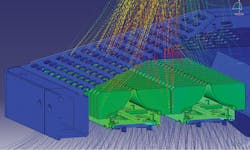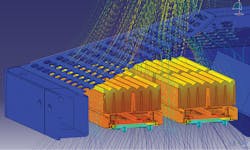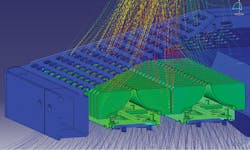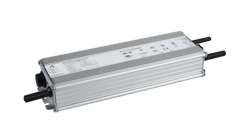DJORDJE ZIVANOVIC and RICHARD OZAKI describe a thermal-design methodology that enabled the development of a new self-cleaning heat sink for an outdoor LED luminaire using simulation tools.
Companies are striving to design innovative and reliable solid-state lighting (SSL) products while reducing the cost of product development and time to market. At the same time, the pace of LED-based product innovation has increased dramatically and is a primary contributor to lighting companies’ overall profits and market share. The challenges in this environment include increasing product complexity and the time and cost required to create physical prototypes. The challenge is especially acute in that SSL development is a multidisciplinary undertaking requiring optical, electronics, mechanical, and thermal skills. Thermal design is especially important in terms of SSL product reliability, and simulation can be critical in developing a good thermal-management scheme in a timely manner. A recent luminaire development by BUCK d.o.o. illustrates the advantages afforded by simulation.
Simulation tools can help lighting manufacturers meet tight market windows even with constrained engineering resources. Such tools allow the development team to perform more and more sophisticated analyses earlier in the development process. Successful products today must be more ergonomic and environmentally efficient. Developing such products, especially in a way that the products can meet customers’ desired price points, requires the design team to evaluate more approaches to elements such as thermal than could reasonably be considered if prototypes of each approach had to be constructed.
Outdoor luminaire design
BUCK is a company in Belgrade that produces luminaires for architectural and medical illumination. The company has expanded its work to outdoor luminaires, and they took on a joint project with Panasonic Serbia to create a self-cleanable heat sink for outdoor lighting fixtures that would improve on an existing extruded heat sink. Thermal design is critical in SSL products because high temperatures can reduce an LED’s light output and cause color shift — effectively shortening the component’s useful effective life. Indeed, heat dissipation design is a key factor in the performance of high-power LEDs.
The thermal management of a street luminaire is particularly challenging because the ambient temperature changes depending on season and location. Finding the optimum solution for thermal problems can take 80% of the time the development team spends on designing a new product.
During the design development phase of the street light fixture, the R&D team started with the question, "How can we solve the cooling of LED modules in the most efficient way?" Based on years of experience in designing heat transfer equipment, the answer was easy: Take the heat away from the LED module, provide enough surface-to-heat dissipation, and provide good airflow.
But some questions weren’t so easy:
• How much airflow is needed to take the heat away at 55°C ambient temperature from the 140W high-power LED module?
• In what way can we provide the optimum heat dissipation surface?
• Where will the hottest air pockets be formed?
Optimizing the heat-sink design empirically would require a lot of time and money. The R&D team decided to use software simulation and analyses to speed up the development time. The computational fluid dynamics (CFD) software they chose, FloEFD from Mentor Graphics, provides guidance and help so that engineers who are not CFD specialists can perform fluid flow, cooling, and other analyses as part of their design process and within their product design tool.
CFD simulation
The software allows engineers to perform CFD automatically — without the attention of a trained specialist. This automation means that product designers can try out a succession of ideas on a design without risking the project deadline, while also reducing simulation time compared to traditional CFD tools.
The CFD software also makes it relatively easy to conduct what-if tests. FloEFD helps create multiple variations of designs by modifying parametric CAD configurations, which can then be analyzed without having to reapply loads, boundary conditions, material properties, and the like. The engineer simply compares the results among the many design options to choose the best possible design.
The simulation software enables product designers as well as specialists to accelerate key decisions at their workstations as they experiment with design scenarios and as they hone in on the best, most efficient, reliable, and cost-effective design. This intuitive virtual prototyping process allows designers to optimize a product during the design stages, with that first physical prototype often being the design that goes into final manufacturing, delivering the best design at lower cost, and getting it to market faster than ever before.
Without simulations, the R&D team would have needed at least 6 to 10 physical prototypes, and the team still wouldn’t have been able to guarantee they had the best solution. Empirical testing would have cost a minimum of three additional months of development time and at least €500 in prototype costs. By using FloEFD, they cut thermal simulation and management time down to one month.
Solid modeling
The team performed the series of simulations in FloEFD based on a parameterized CAD model created in CATIA V5, a solid modeling tool. FloEFD V5 is a concurrent CFD product, and that allows the model to be immediately available for analysis preparation within the CATIA environment. Engineers use a configuration wizard to prepare the solid model by applying loads and boundary conditions and finally meshing the model before analyzing it. By designing the heat-sink model in CATIA as a mechanical model and simulating with FloEFD from the thermal standpoint, the thermal properties can be attached to all the potential shapes considered for the heat sink, and the LED module that is the source of heat.
After the design optimization of the heat sink, the team obtained data on the number, height, and thickness of the fins that would provide the best possible heat dissipation for the LED modules (Fig. 1). As part of the optimization process, the team also wanted to test the effect on cooling of dust accumulation over the top of the heat sink.
Dust/dirt deposition reduces the available surface area for heat transfer, creates additional thermal resistance for heat to get to the ambient, and reduces the amount of airflow that can travel between the heat-sink fins removing heat. In the simulation, the team added a component to represent dirt/dust placed over the top of the heat sink (Fig. 2).
Self-cleaning design
In addition to optimum cooling, the goal of the team included designing a self-cleaning heat sink. The desired self-cleaning effect requires high air velocities relative to natural passive convection standards, in order to minimize dirt deposition. The airflow was simulated using the FloEFD particle study feature. The particle study feature in the simulation software permits injection of virtual particles with a material diameter and mass into the fluid flow to determine where particles will accumulate and erode surfaces. This lets the engineers visualize where dirt will fall out of the flow and gather on the heat sink, or preferably be carried out of the heat sink.
The use of thermal simulation software both significantly shortened the development time of the SSL product and provided operational details that would have been difficult to obtain otherwise. The result for BUCK was the design of a new heat-sink model with vertical fins, which features a higher airflow for the self-cleaning effect that prevents dirt deposition (Fig. 3).
The self-cleaning heat sink has a similar mass to the original one, but it doesn’t need as much additional work and time on the milling machine. The simpler manufacturing process resulted in not only cost savings but also significantly reduced maintenance in the end product, and achieved longer product life.
Modeling the LEDs
The team also utilized a new FloEFD LED module feature that delivered reliable results effortlessly. The values from the FloEFD simulations were within 3% of the results obtained later by measurements on the physical model.
The LED module in FloEFD simulates an LED component as a compact package based on either a simple two-resistor model or an advanced measurement-derived model. The detailed model includes a unique solution to the challenge of designing SSL and allows thermal and photometric models of LEDs obtained from testers to be used in FloEFD under constant-current operating conditions.
The model correctly accounts for power that is emitted as light when calculating the heat dissipation in the LED, with the temperature, power consumption, and light output (hot lumens) predicted by the software. A starter pack of commercially available LED models is provided as part of the module, which also includes the ability to account for absorption of radiation in semi-transparent solids such as a lens in front of the LED, and the ability to simulate a circuit board as a compact model with biaxial thermal conductivity.
A company-specific LED model can also be input and simulated by specifying forward current for the LEDs. The software calculates the correct thermal heating power and a physically validated operating temperature. It allows building of an accurate thermal radiation analysis that is capable of simulating absorption of radiation in semi-transparent solids such as glass, as well as taking into account effects such as refraction, specular reflection, and wavelength dependency (spectrum properties of the radiation). Light quality from the LEDs can also be calculated to see whether they meet the design goals for light output and uniformity.
The BUCK designers used the FloEFD thermal simulation software embedded in CATIA to meet the goal of designing a new heat sink with vertical fins, a higher airflow, and a self-cleaning effect that prevents dirt deposition. By using the thermal simulation software, they significantly shortened the development time and were provided with details they couldn’t otherwise see to analyze their prototype. They also were able to obtain the experience that contributes to faster and better solutions of future problems. The new heat-sink design enabled the company to reduce the cost of manufacturing and maintenance as well as extend the product life. The company’s final LED-based luminaire called Tangram (Fig. 4) also won a Good Design Award from the Chicago Athenaeum Museum of Architecture and Design.
Acknowledgment
The authors wish to acknowledge the support received in writing this article from Mircea Slanina, the responsible account manager working with TRIAS microelectronics SRL, a Mentor Graphics distributor.
DJORDJE ZIVANOVIC is an industrial designer at BUCK d.o.o. RICHARD OZAKI is a senior application engineer for European customers in the mechanical analysis division of Mentor Graphics Corporation.










